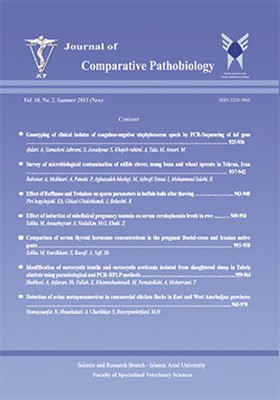Microfluidics and improving the cell culture channel: evaluation of spermatogonial stem cells using microfluidic chips
Subject Areas : Journal of Comparative PathobiologyS. Naeemi 1 , A.M. Kajbafzadeh, 2 , A. Eidi, 3 , R. Khanbabaee, 4 , H. Sadri-Ardekani 5
1 - PhD candidate, Department of Biology, Science and Research Branch, Islamic Azad University, Tehran, Iran
2 - Pediatric Urology and Regenerative Medicine Research Center, Gene, Cell & Tissue Research Institute, Children Medical Center, Tehran University of Medical Sciences, Tehran, Iran
3 - Full Professor, Department of Biology, Science and Research Branch, Islamic Azad University, Tehran, Iran,
4 - Department of Biology, Qaemshahr Branch, Islamic Azad University, Qaemshahr, Iran.
5 - Wake Forest Institute for Regenerative Medicine, Wake Forest School of Medicine, Medical Center Boulevard, Winston-Salem, NC 27157, USA.
Keywords: Spermatogonial stem cells, Microfluidic system, Scaffold, PLZF, TEKT1, TP1,
Abstract :
The main purpose of the present study was to investigate the treatment of male infertility, because infertility treatment is important in the group of cancer patients treated with gonadotoxic drugs. The main approach of the mentioned study is to compare two different groups of spermatogonia stem cell culture methods and to evaluate the efficiency of differentiation and proliferation of these group of cells. Successful transplantation of spermatogonia stem cells (SSCs) in laboratory studies requires a suitable microenvironment for proliferation and differentiation of these cells. The natural extracellular matrix provides a good environment for stem cell culture. In the present study, themain purpose was to evaluate the ability of spermatogonial stem cells proliferation and differentiationvia the utilizing the microfluidic device (ex vivo). On the other hand, in the present study, we compared the obtained resultswith culture conditions in conventional culture plates (in vitro) to compare the SSCs proliferation and differentiation ability. In in-vitro culture method first spermatogonia stem cells from neonatal mice were isolated, then the resulted cells were seeded in culture plates on a scaffold consisting of hyaluronic acid, chitosan and decellularized testicular tissue, furthermore, in ex-vivo study the extracted spermatogonial stem cells were cultured in the microfluidic system without a scaffold. In ex vivo study, spermatogonial stem cells were extracted from neonatal male NMRI mice. The extracted cells were transferred to a microfluidic chip that was designed without an external pump, thereafter, the culture process was evaluated by IHC evaluation after one-month culture. In examined samples, cell attachment to the seminiferous tubules, DAPI staining and immunohistochemistry were evaluated. The results of immunohistochemical studies showed a significant increase in the expression of PLZF and TEKT1 markers in ex-vivo models. Finally, the results revealed that the ability of spermatogonia stem cells to induce spermatogenesis and production of haploid cells under testicular tissue culture in the microfluidic system is much more significant than conventional culture conditions in laboratory plates for these cells.
- Sanjo H, Komeya M, Sato T, Abe T, Katagiri K, Yamanaka H, et al. In vitro mouse spermatogenesis with an organ culture method in chemically defined medium. PLoS One. 2018;13(2.(
- Reda A, Hou M, Winton T, Chapin R, Söder O, Stukenborg J-B. In vitro differentiation of rat spermatogonia into round spermatids in tissue culture. Mhr: Bas Sci Rep Med. 2016;22(9.(
- Weinbauer GF, Luetjens CM, Simoni M, Nieschlag E. Physiology of testicular function. Androl: Springer; 2010. p. 11-59.
- Vermeulen M, Del Vento F, De Michele F, Poels J, Wyns C. Development of a cytocompatible scaffold from pig immature testicular tissue allowing human sertoli cell attachment, proliferation and functionality. Int JMol Sci. 2018;19(1).
- Aoshima K, Baba A, Makino Y, Okada Y. Establishment of alternative culture method for spermatogonial stem cells using knockout serum replacement. PLoS One. 2013;8(10).
- Alrahel A, Movahedin M, Mazaheri Z, Amidi F. Study of Tnp1, Tekt1, and Plzf genes expression during an in vitro three-dimensional neonatal male mice testis culture. Iranian Biomed J. 2018;22(4).
- Yu F, Hunziker W, Choudhury D. Engineering microfluidic organoid-on-a-chip platforms. Micromachine. 2019;10(3).
- Mirzapour T, Movahedin M, Tengku Ibrahim T, Koruji M, Haron A, Nowroozi M, et al. Effects of basic fibroblast growth factor and leukaemia inhibitory factor on proliferation and short‐term culture of human spermatogonial stem cells. Androl. 2012;44.
- Naeemi S, Eidi A, Khanbabaee R, Sadri-Ardekani H, Kajbafzadeh A-M. Differentiation and proliferation of spermatogonial stem cells using a three-dimensional decellularized testicular scaffold: a new method to study the testicular microenvironment in vitro. Int Urol Nephrol. 2021.
- Komeya M, Hayashi K, Nakamura H, Yamanaka H, Sanjo H, Kojima K, et al. Pumpless microfluidic system driven by hydrostatic pressure induces and maintains mouse spermatogenesis in vitro. Sci Rep. 2017;7(1).
- Rajab TK, O’Malley TJ, Tchantchaleishvili V. Decellularized scaffolds for tissue engineering: Current status and future perspective. Artif Organ. 2020;44(10).
- Berthier E, Young EW, Beebe D. Engineers are from PDMS-land, Biologists are from Polystyrenia. Lab on a Chip. 2012;12(7).
- Halldorsson S, Lucumi E, Gómez-Sjöberg R, Fleming RM. Advantages and challenges of microfluidic cell culture in polydimethylsiloxane devices. Biosensor Bioelectronic. 2015;63.
14. TehranirokhM, Kouzani AZ, Francis PS, Kanwar JR. Microfluidic devices for cell cultivation and proliferation. Biomicrofluidic. 2013;7(5).
- Berdichevsky Y, Sabolek H, Levine JB, Staley KJ, Yarmush ML. Microfluidics and multielectrode array-compatible organotypicslice culture method. J Neurosci method. 2009;178(1).
- Wagner I, Materne E-M, Brincker S, Süßbier U, Frädrich C, Busek M, et al. A dynamic multi-organ-chip for long-term cultivation and substance testing proven by 3D human liver and skintissue co-culture. Lab on a Chip. 2013;13(18).
- Pendergraft SS, Sadri-Ardekani H, Atala A, Bishop CE. Three-dimensional testicular organoid: a novel tool for the study of human spermatogenesis and gonadotoxicity in vitro. Biol Rep. 2017;96(3).
- Komeya M, Kimura H, Nakamura H, Yokonishi T, Sato T, Kojima K, et al. Long-term ex vivo maintenance of testis tissues producing fertile sperm in a microfluidic device. Sci Rep. 2016;6(1).
- Baert Y, Rombaut C, Goossens E. Scaffold-based and scaffold-free testicular organoids from primary human testicular cells. Organoid: Springer; 2017. p. 283-90.
- Azizi H, Koruji M, Skutella T. Comparison of PLZF Gene Expression between Pluripotent Stem Cells and Testicular Germ Cells. CellJ. 2020;22(1).


